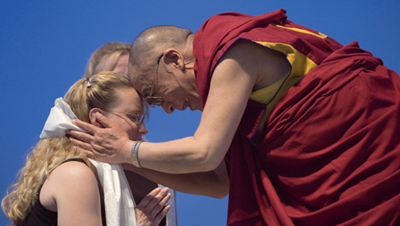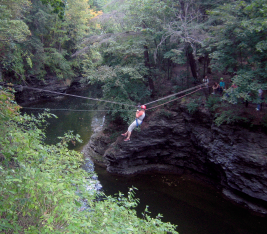Dalai Lama Makes The Case For Peace, Plus: Astronomers Aim To Save Arecibo, A Degree In Ethiopia, $85 Million Facility Breaks Ground, Ecologist Names Culprit For worldwide Ills
DALAI LAMA MAKES THE CASE FOR PEACE
To a soundtrack of thunder and driving rain pounding the roof of Barton Hall, His Holiness the Fourteenth Dalai Lama addressed a capacity crowd of more than 5,000 in October. The spiritual leader of Tibetan Buddhism last visited Cornell in 1991; Ithaca is home to the North American seat of his personal monastery. His trip—which also featured talks at Ithaca College and a downtown theater, as well as the viewing of sand mandalas at the Johnson Museum—included the blessing of a new monastic facility to be built outside of town.
At Barton, he gave a speech entitled "A Human Approach to World Peace," repeatedly calling his audience "my human brother-sisters." Sitting cross-legged on an upholstered chair, speaking English with the occasional aid of a translator, he noted that "peace doesn't mean absence of violence." He cited the example of the Cold War: "That is not genuine peace—a peace of fear." Often displaying an engaging sense of humor, the Dalai Lama declared that unlike carnivorous animals, human beings have "gentle" bodies without claws or fangs—prompting laughs when he proceeded to growl and describe a French friend who has very long fingernails. "We are social animals," he said. "One individual's future is very much dependent on the rest of humanity."


Advocate for peace: Before the Dalai Lama spoke at Barton Hall, monks from the Namgyal Monastery Institute chanted for a half-hour (above left). After he was introduced by President Skorton, the Tibetan Buddhist leader made the point that genuine peace is not just "absence of violence" (above right). After his address, he thanked Mareike Larsen and Susan Wardwell for serving as American Sign Language interpreters during the program (top).
Star Trek
ASTRONOMERS AIM TO SAVE ARECIBO
Cornell's Arecibo observatory, set for sever federal budget cuts that could lead to its closure, may get a reprieve. The world's most sensitive radio telescope was the subject of a two-day scientific meeting held in Washington, D.C., in September. More than seventy astronomers discussed the observatory's future, making a scientific case for its continued existence. A few weeks later, two U.S. Representatives introduced a bill seeking to guarantee Arecibo's funding. Said Congressman Luis Fortuño of Puerto Rico: "Maintaining this facility is an investment in our nation's future. The cost is small compared to the benefits for America and mankind." Congressional hearings on the importance of detecting potentially dangerous near-Earth asteroids—a field in which Arecibo is a leader—are scheduled for November.
Sacred Space
A WIDER AUDIENCE FOR SAGE?
In the hope of reversing a longtime decline in attendance at Sage Chapel, the director of Cornell United Religious Work has launched new programs and made some logistical changes—including moving Sunday services from 11 a.m. to 4 p.m. The new time, says the Reverend Kenneth Clarke Sr., is "more student friendly." Clarke has also tried to reach out to the Cornell community via musical programs, and has organized events around monthly themes such as "faith and reason." The 800-seat chapel, opened in 1875, will continue its traditional offerings such as Monday candle-lightings and Wednesday organ concerts. "Amidst the busy, frenetic life of an Ivy League land-grant institution, and particularly in Cornell culture," says Clarke, "where you have hard-working and driven students committed to scholarly rigor, with all the excitement and the stresses that come with that, this is one of the few spaces on campus where there's an opportunity to reflect on one's life, one's experiences."
Online & Upward
A NEW WEBSITE FOR CAM
Cornell Alumni Magazine will revamp its website over the next year, aiming for dramatic improvements to an online presence that was originally launched in 1995. "We're hoping this will be much more engaging for the alumni community than our current site," says the magazine's editor and publisher, Jim Roberts '71. Proposed additions include putting more content online and maintaining a staff-run journal of local news and campus events. Although the effort was made possible by support from the University, Roberts stresses that the site's content—like that of the print magazine—will remain editorially independent of Cornell. "We're excited about the ability to show a broader range of information," says Vice President for University Communications Tommy Bruce. "This is a great group of writers and editors who need to be playing on a larger canvas." The new site is scheduled to debut in early 2008.
 Learning the ropes: A Tyrolean traverse across Fall Creek Gorge was among the training offered at the Northeast Wilderness Medicine Conference, held on campus in late September. More than 150 doctors, EMTs, and other health-care professionals attended the conference, whose organizers included Cornell Outdoor Education and Weill Cornell Medical College. Participants explored the perils of altitude sickness, diving accidents, snakebites, hypothermia, and more.
Learning the ropes: A Tyrolean traverse across Fall Creek Gorge was among the training offered at the Northeast Wilderness Medicine Conference, held on campus in late September. More than 150 doctors, EMTs, and other health-care professionals attended the conference, whose organizers included Cornell Outdoor Education and Weill Cornell Medical College. Participants explored the perils of altitude sickness, diving accidents, snakebites, hypothermia, and more.
Safety First
CU UPDATES EMERGENCY PLAN
In the wake of the virginia tech shootings and the effects of Hurricane Katrina on colleges in New Orleans— as well as concerns about the security of chemicals in campus labs—Cornell is taking steps toward stronger emergency planning. Focusing on keeping the University community informed, officials are working to provide better information about emergencies using text messages, cell phones, and alert sirens. They're also formulating plans for responding to everything from a blizzard to a flu pandemic. "How do you continue business, or at least the essential services and research, during an emergency?" asks Peggy Matta, Cornell's new director of emergency planning and recovery. Emergency plans within all colleges and major administrative units will be developed and updated to better prepare students, faculty, and staff. Says Dr. Janet Corson-Rikert, executive director of Gannett Health Services: "This anticipatory planning, planning for a crisis of absenteeism, involves the entire university."
Don't Pollute
ECOLOGIST NAMES CULPRIT FOR WORLDWIDE ILLS
Pollution of water, air, and soil is responsible for about 40 percent of deaths worldwide, says Cornell ecology professor David Pimentel, PhD '51. In an article to be published in the journal Human Ecology in December, Pimentel and a team of Cornell graduate students argue that the environmental fallout from pollution damages the health of some 3.7 billion people. Perils include waterborne infections, toxic chemicals, and the rise of drug-resistant microbes. "We have serious environmental resource problems of water, land, and energy," says Pimentel, whose team reviewed data from more than 120 published papers to reach their conclusions, "and these are now coming to bear on food production, malnutrition, and the incidence of diseases.
D-Lovely
NEW eCOMMONS SITE UNVEILED
Cornell
's dspace online digital repository has gotten a make-over, reemerging as a more user-friendly site called eCommons@Cornell. The site is
an eclectic collection of archives and information: a virtual tour of Cornell Plantations; articles on the status of Muslim women; a video on famed physicist Hans Bethe; a downloadable file containing Andrew Dickson White's two-volume History of the Warfare of Science with Theology. It is also home to an archive of Cornell Alumni Magazine and other University-related publications. The site can be found at http://ecommons.library. cornell.edu.
Good News
TOP HONORS FOR ENGINEERS
For the third year in a row, the university's engineering physics program has been rated best in the nation by U.S. News & World Report. In the magazine's latest ranking of colleges and universities, Cornell was rated twelfth overall (the same as the previous year), tying with Washington University in St. Louis. The University took fourth place in the category of economic diversity, calculated by the percentage of undergrads receiving Pell Grants.
Provost Post
MARTIN'S DEPUTY NAMED
David harris, cornell's vice provost for social sciences, has also been named deputy provost, a new position established in August. The creation of the post, Provost Biddy Martin says, "will allow me to work even more directly with the deans to ensure that we enhance the quality of our faculty and programs as we face the challenge of replacing hundreds of faculty and moving in new research directions." Harris's new duties include coordinating the work of vice provosts and focusing on diversity issues.
Africa Bound
A DEGREE IN ETHIOPIA
Starting this fall, cornell will offer its first degree program in Africa. One of the University's few degrees that does not require a period of residence at a Cornell campus, the Master of Professional Studies (MPS) in international agriculture and rural development will be offered in conjunction with Ethiopia's Bahir Dar University. Designed to help students develop skills in hydrology, watershed management, project administration, and communication, the degree will require thirty credit hours of instruction. It's intended for students from African universities who plan to work on grassroots development projects, though Ithaca-based students will be able to take courses and conduct research there as well. "It's been fascinating—and daunting—to pull this together and to make sure that systems we have at Cornell will work in Ethiopia," says Alice Pell, professor of animal science and one of the program's developers.
Scientific Method
$85 MILLION FACILITY BREAKS GROUND
Construction of the new physical sciences building has begun on East Avenue between Rockefeller Hall and Baker Lab. Offering enhanced research and teaching space for chemistry, chemical biology, physics, and other fields, the facility is designed to invite collaboration. "Some of the most interesting work in science occurs at the boundaries between disciplines," says Arts and Sciences dean Peter Lepage. The new building, he says, "will bring Cornell's culture of scientific collaboration—one of the strongest in the country—to a new level." Scheduled for completion in fall 2010, the $85 million project will include more than eighty research and teaching laboratories as well as meeting spaces, a 120-seat auditorium, study areas, and a café.


